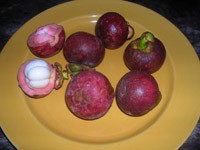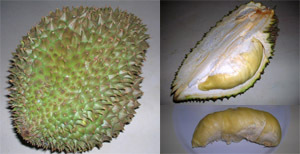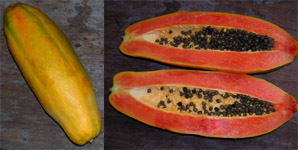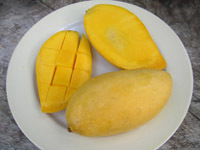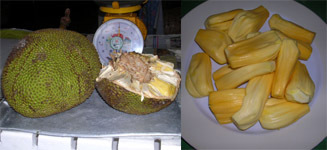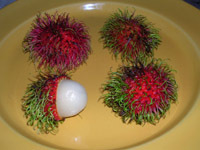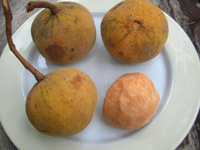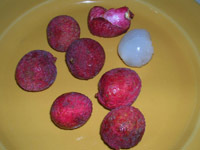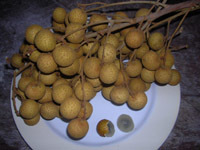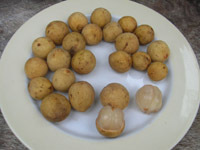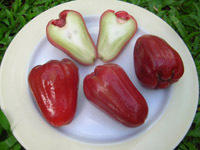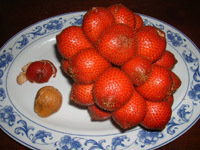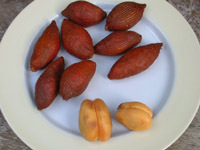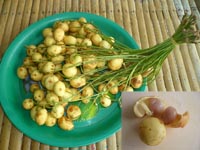Thai Fruits
One of the delights of visiting a tropical climate is trying the fresh tropical fruits. Many of these fruits do not make it to western markets because they do not travel well enough. Most of the fruits that do appear in western markets will not retain the freshness they have at their point of origin. Not to mention the huge difference in price with many of these fruits considered luxury items in the west.
Everybody knows bananas, pineapples, coconuts, etc but this is just the tip of the iceberg. There is a huge range of fruits available in Thailand. Some are native to Thailand and some have been introduced from other tropical regions and are now grown locally. The fruits available vary by season. Some fruits are available all year round; some have a peak season while others are only available a few months a year. Thais often look forward to the arrival of their favourite fruit. Prices vary depending on the season and quality of the fruit.
Mangosteen (Thai Name: Mangkoot)
In season price range:
20-50 baht per kilo
Sometimes called the Queen of Thai fruit, these are a real treat. Select fruit that are slightly soft when you squeeze them. A firm squeeze cracks open the fruit casing revealing the delicious sweet white fruit. The fruit is split into segments some of which have small stones.
Durian (Toorian)
In season price range:
20-60 baht per kilo
This is the King of Thai fruit. This distinctive fruit can grow up to 5kgs and has a spiky green to brown casing. It is renowned for its strong musty aroma which often discourages people from even trying it. If you can overcome your reaction to the smell then the golden flesh is smooth, creamy and distinctive. The Thais love them but they are an acquired taste.
You can buy the fruit ready peeled or you will need a knife to cut the casing and then prise it open.
Sweet Tamarind (Makarm)
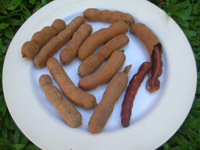 Season:
Season:
Peak September to November
In season price range:
80-120 baht per kilo
This is another signature fruit of Thailand. It is a sweet version of a fruit that is usually sour and used to flavour savoury dishes or make preserves. The sweet version grows all over Thailand and can be eaten fresh. They grow on trees and come in long pods between two and six inches long. Crack the pods open and pull away the viney strands that may be around the fruit. The fruit is long, sticky, and dark and contains some inedible seeds. It is sweet with a texture like soft raisins.
Papaya (Malagor)
In season price range:
10-50 baht per kilo
This long, oblong fruit was imported to Asia from Mexico over 400 years ago.
When they are still green and sour, they are used as the prime ingredient
of the popular Thai dish som-tam. The green papaya is cut into thin strips
and then beat in a mortar and pestle with other ingredients such as limejuice,
garlic, chilies, dried prawns, raw crab or salted fish. When the fruit is
ripe, it turns yellow or orange. Cut the fruit open with a knife, scrape out
the seeds and then scoop out the mellow tasting fruit.
Mango (Mamuang)
In season price range:
40-80 baht per kilo
Thai mangos are among the sweetest in the world. The Thais eat them in a variety
of ways. Some are eaten when they are still green and sour. At this time,
you can eat them with a sugar/salt dip or use them to make sour salads like
som-tam which is normally made from papaya but green mango is an alternative.
When mangos are ripe, they turn to yellow or orange and become very sweet.
Use a knife to peel them or slice the fruit away from the long, flat stone
in the middle. The best mangos are mouthwateringly sweet and melt on the tongue.
Thais like to eat sweet mangos with sticky rice and sweetened coconut milk.
Jack Fruit (Kanoon)
In season price range:
30-60 baht per kilo
These big fruits are ugly and smelly. They are the largest tree borne fruit
in the world growing in excess of 30 kilos. Despite their unappealing outer
appearance the fruit inside is crisp, crunchy and fresh tasting. Cut open
the main fruit and inside are a multitude of yellow fruits. Each fruit is
a flattened apple shape containing a single stone. You can buy jack fruits
whole or buy the yellow fruits cut out and ready to eat.
Rambutan (Ngor)
In season price range:
10-30 baht per kilo
Break into the fruit casing with your fingers and peel it away to reveal the fruit. A sweet, sticky, white fruit with a single stone in the middle. Either nibble the fruit off the stone or open it with your fingers and remove the stone.
Dragon Fruit (Gair-ow Mang Gorn)
In season price range:
30-60 baht per kilo
This spectacular looking fruit is best eaten chilled. Use a knife to cut the fruit in half lengthways and scoop the fruit out with a spoon. The centre is a solid mass of white flesh with lots of tiny black seeds. There is a slightly smaller version of the fruit with red flesh. One of the pleasures of this fruit is that you can eat the entire centre leaving just the casing. If the fruit is not fully ripe then it tastes a little bland and disappointing. When they are fully ripe, they are sweet and flavoursome. Look for fruit with rich red and pink colours.
Santol (Gratawn)
In season price range:
20-40 baht per kilo
This round yellow to green fruit should be peeled with a knife. The fruit has an outer layer that is firm and slightly sour. The centre is soft and sweet. You need to suck this sweet centre from the seeds.
Lychee (Linchee)
In season price range
50-90 baht per kilo
Originally from China, this fruit is now widely grown in northern Thailand.
It is hugely popular worldwide and is exported fresh and tinned. It grows
on trees in loose bunches. The leathery casing is pink to red in colour and
easy to break open. The fruit has a single small stone and is sweet and delicious.
Longon (Lam Yai)
In season price range:
20-50 baht per kilo
This is one of the classic Thai fruits and hugely popular with the locals. There is even a popular song called ‘Khun Lam Yai’, although in the lyrics a woman objects to being compared with the fruit. The fruit grows in bunches like grapes. The brown casing is crisp and easy to break. The creamy grey fruit is wrapped around a single stone and has a texture and taste similar to Lychee. As well as eating it fresh, the fruit is also tinned and available worldwide.
Langsat (Longkorng)
In season price range:
40-90 baht per kilo
This fruit grows in bunches and from the outside is similar in appearance to Longons. Break into the leathery casing with your fingers to reveal the creamy grey flesh which is split into segments. It has a sweet taste with a sour edge and is very sticky. Some of the segments have seeds which should not be chewed as they are very bitter.
Rose Apple (Champoo)
In season price range:
40-100 baht per kilo
These attractive bell shaped fruits come in shades of red and green. They are crisp, crunchy and light with a fresh taste. You can eat the whole fruit but many people prefer to leave the core.
Pomello (Som-oh)
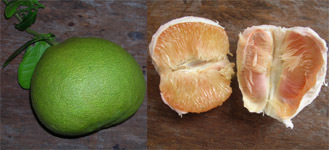 Season:
Season:
Peak August to October
In season price range:
30-60 baht per fruit
This large, round, green fruit is similar to grapefruit but it is not as juicy
or sour. Remove the thick peel with a knife and then you can cut out the segments.
The flesh is pink to green, crisp and refreshing to eat.
Custard Apple or Sugar Apple (Noi Nah)
 Season:
Season:
Peak June to September
In season price range:
30-80 baht per kilo
This fruit is the size of a large apple and covered in green scales. You can
peel it or cut it open with a knife. The fruit inside is white, soft and sweet.
You can pick the seeds out with a spoon or just suck the fruit off the seeds
and spit the seeds back out.
Snake Fruit (Ragam)
In season price range:
20-40 baht per kilo
A member of the Salacca family this fruit grows in tight clusters. It is reddy brown with lots of sharp little spines. Pinch off the tip of the fruit and then peel from there. There are usually two or three sections of fruit inside. The fruit is firm rather than juicy. There is not a lot of flesh as each section contains a sizeable stone in the middle. Nibble the light brown flesh from the stone. A distinctive smoky flavour with a tangy aftertaste.
Sala (Sala)
In season price range:
30-60 baht per kilo
Like the Snake Fruit, the Sala is also a member of the Salacca family. It is very similar to the snake fruit in both appearance and taste. It is longer and thinner and grows in a more open bunch. It has more flesh than the snake fruit and is therefore held in higher regard.
Mafai (Burmese Grape)
In season price range:
60-100 baht per kilo
These are not such a common sight around the markets but they can be found often enough. They are a tree borne fruit that grows in evergreen forests across much of Asia. The fruit comes in bunches and each fruit is a small oval with a leathery casing. Inside are two or three segments of pinkish to purple fruit with a small stone inside. They have a sour taste and a tongue drying tannin effect.

